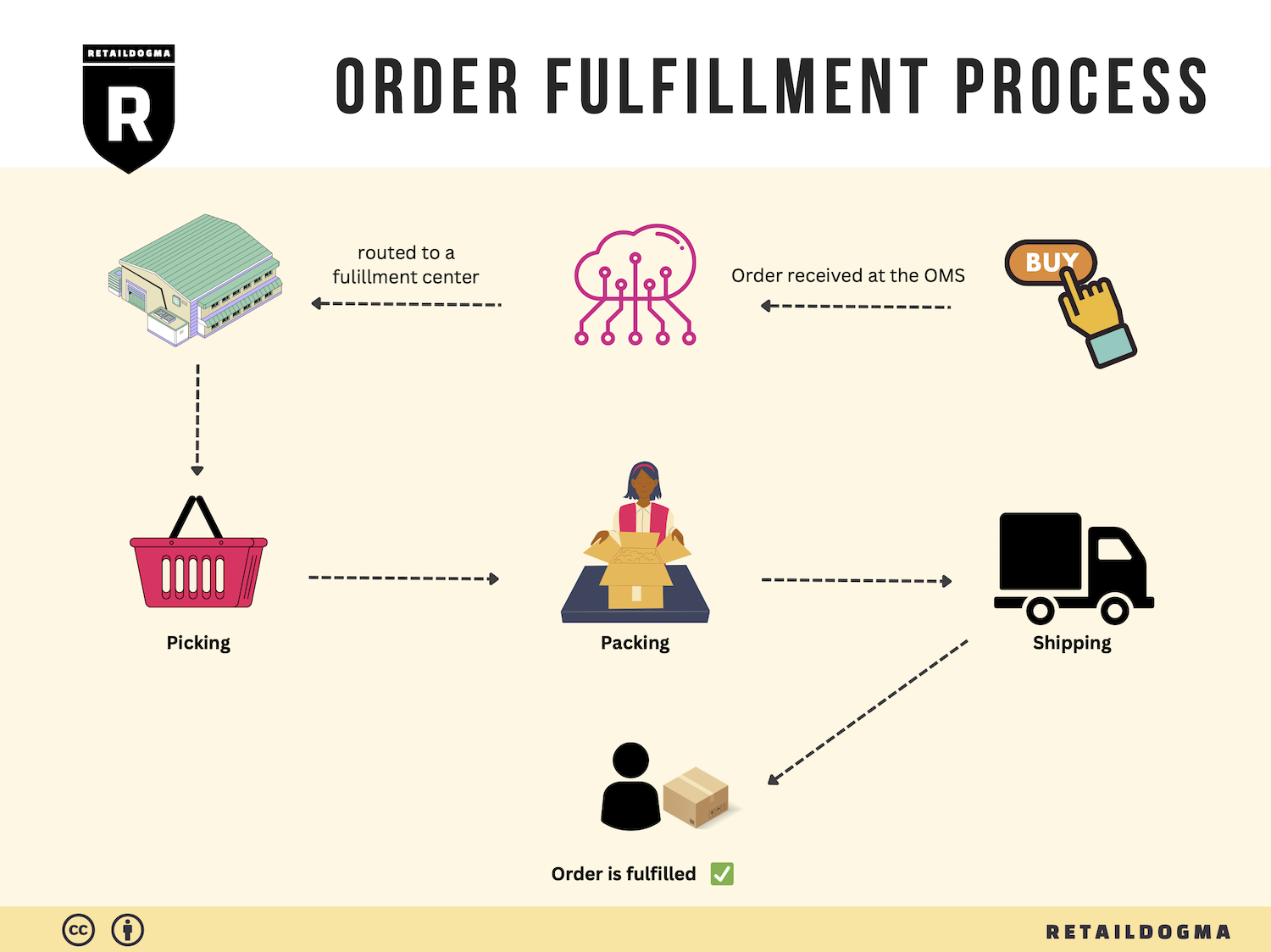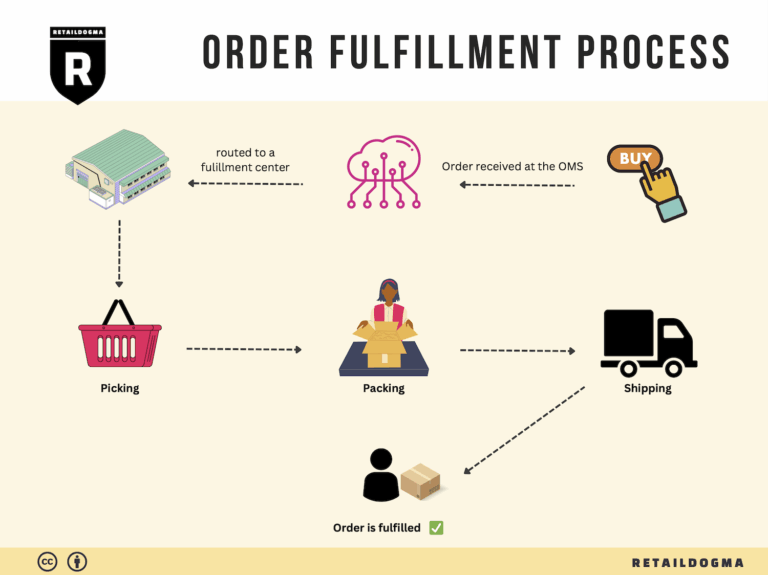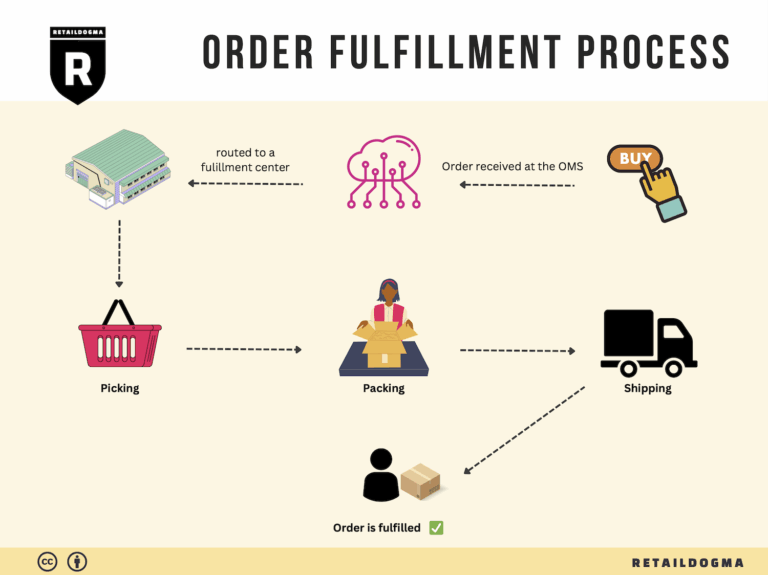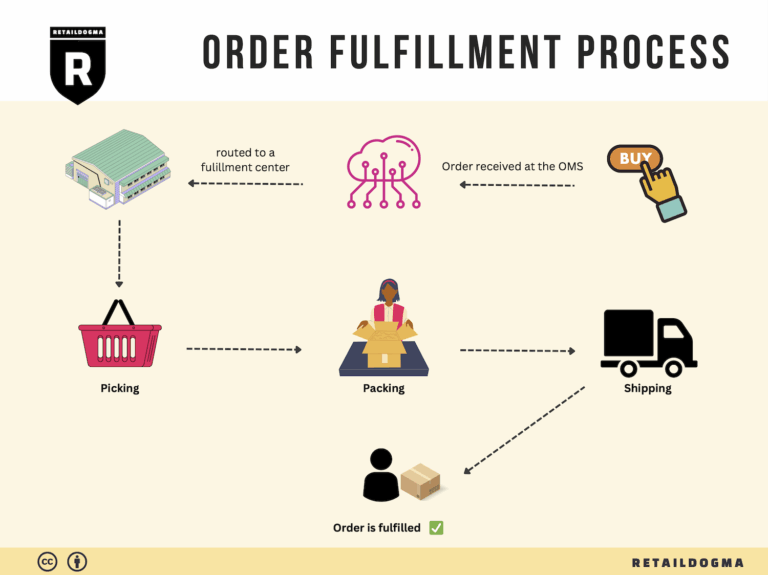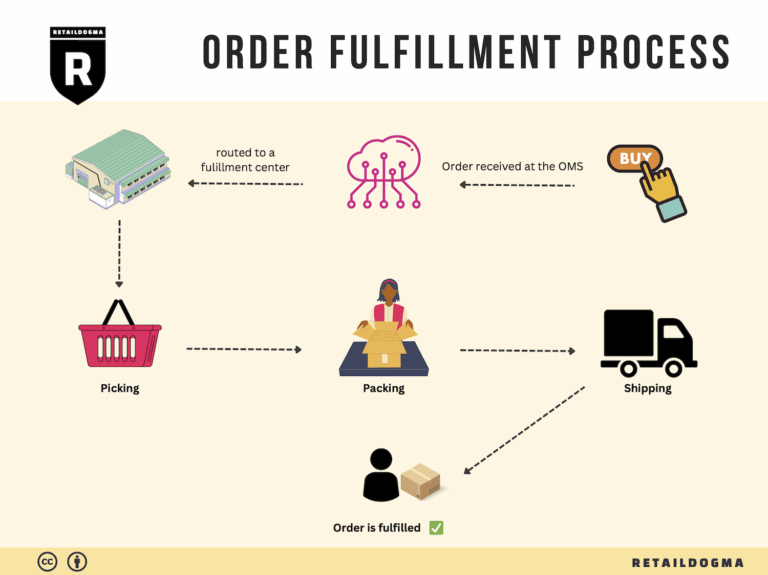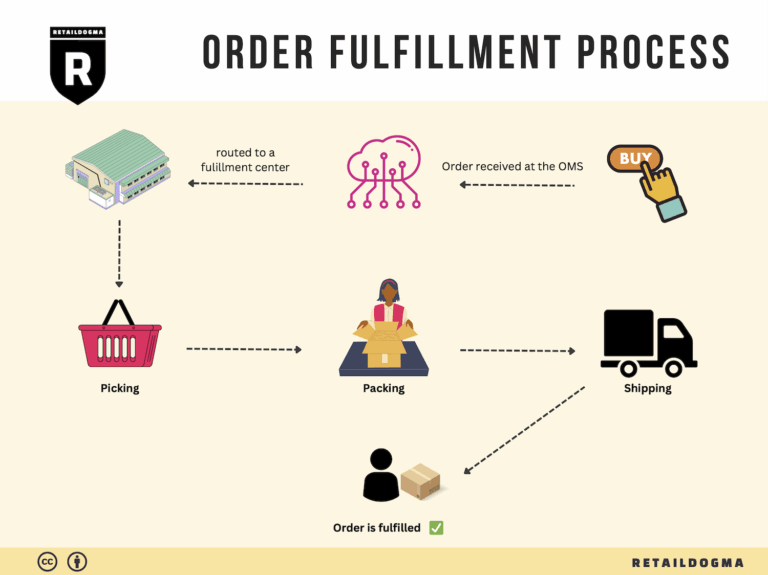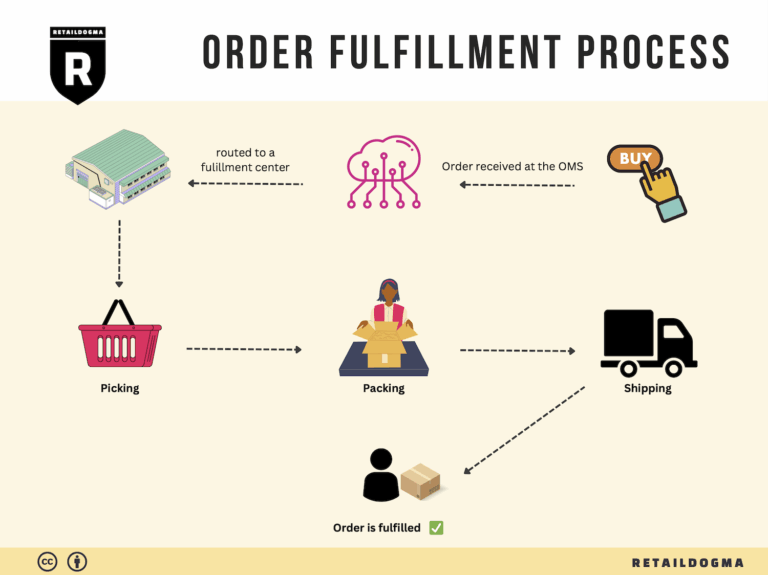Ecommerce Fulfillment Services: The Ultimate Guide (2025)
What is E-commerce Fulfillment? An Introduction for Growing Businesses
Navigating the Challenges of Order Fulfillment
As an e-commerce business owner, the excitement of growing sales can quickly turn into an overwhelming burden when it comes to packing and shipping orders. Many entrepreneurs find themselves bogged down by the logistics of fulfillment, spending precious time on tasks that detract from their core business activities. This is a common pain point for growing online businesses: balancing the thrill of scaling with the operational demands of delivering products to customers efficiently.
Fulfillment, in its simplest form, is the process of getting a product from your inventory to your customer’s doorstep. This process encompasses everything from receiving and storing inventory to picking, packing, and shipping orders. The effectiveness of your fulfillment strategy can significantly impact customer satisfaction, repeat business, and ultimately, your bottom line.
In this guide, we will explore the various models of e-commerce fulfillment available to growing businesses, including Third-Party Logistics (3PL) and Fulfillment by Amazon (FBA). Each model has its unique advantages and challenges, and understanding these can help you determine the best fit for your business needs.
We will also delve into the core services offered by fulfillment providers, such as inventory management, order processing, shipping options, and customer service. Knowing what services are essential for your operation will allow you to streamline your processes and enhance your customers’ experience.
Choosing the right fulfillment partner is crucial for your e-commerce success. This guide will provide insights into the key factors to consider when selecting a fulfillment provider, including their technology integration capabilities, shipping networks, and scalability options.
Finally, we will discuss pricing structures associated with different fulfillment solutions, helping you to navigate the costs involved and make informed financial decisions.
The goal of this guide is to empower you, the business owner, to make smart, strategic decisions about your logistics. By understanding the intricacies of e-commerce fulfillment, you can position your business for sustainable growth, allowing you to focus on what you do best: creating great products and serving your customers.
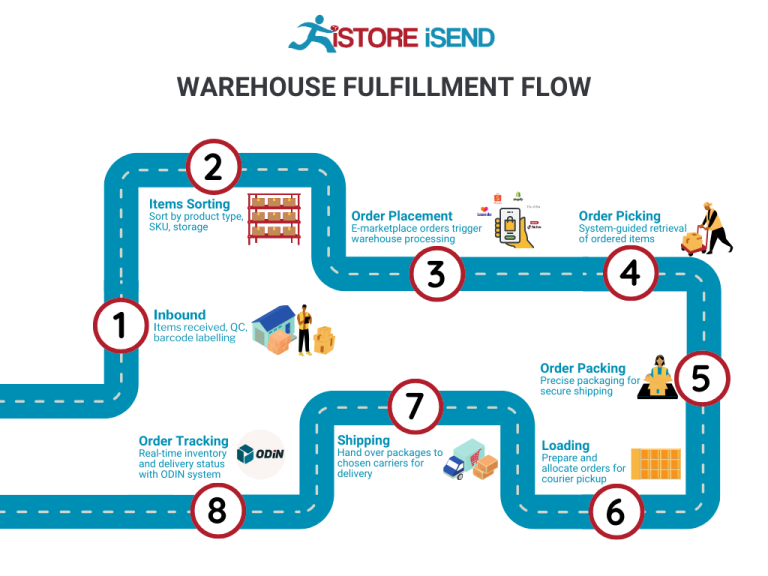
What You’ll Learn In This Guide
- What is E-commerce Fulfillment? An Introduction for Growing Businesses
- The Order Fulfillment Process: From ‘Buy’ Button to Customer’s Door
- Comparing Fulfillment Models: In-House vs. 3PL vs. Dropshipping
- A Deep Dive into Amazon FBA: Pros, Cons, and Who It’s For
- Core Services Offered by Fulfillment Centers
- How to Choose a Fulfillment Partner: A 6-Point Checklist
- Understanding Fulfillment Pricing: A Breakdown of Common Fees
- Frequently Asked Questions (FAQs) about Fulfillment
- Conclusion: Is Outsourcing Fulfillment the Right Move for Your Business?
- Important Disclaimer
The Order Fulfillment Process: From ‘Buy’ Button to Customer’s Door
1. Receiving Inventory
The order fulfillment process begins with receiving inventory at the fulfillment center. Upon arrival, products are checked against the purchase order to ensure accuracy—this includes verifying quantities, conditions, and any specific requirements outlined by the vendor. This step is crucial as it sets the foundation for efficient inventory management and order fulfillment.
Key Term: SKU (Stock Keeping Unit)
Each product is assigned a unique SKU, which simplifies inventory tracking and management. By utilizing SKUs, fulfillment centers can quickly identify products, monitor stock levels, and streamline the receiving process. Accurate receiving prevents discrepancies that could lead to stockouts or overstock situations, both of which can negatively impact customer satisfaction and operational efficiency.
2. Warehouse Storage
Once the inventory has been successfully received and verified, it is then organized and stored within the warehouse. Efficient warehouse storage is vital for optimizing space and facilitating easy access to products. Items are often categorized based on various factors such as size, type, and sales velocity. This categorization aids in minimizing retrieval times during the order-picking stage.
Key Term: ABC Analysis
This inventory management technique categorizes products into three groups based on their importance: A (high-value items), B (moderate value), and C (low-value items). By implementing ABC analysis, businesses can prioritize their storage strategies, ensuring that high-demand items are easily accessible and minimizing unnecessary movement within the warehouse. Proper storage contributes to faster order fulfillment and enhances the overall efficiency of the supply chain.
3. Order Picking
As orders are placed through the e-commerce platform, the next step is order picking, where items are retrieved from storage. This process involves generating pick lists, which outline the items needed for each order, including their locations within the warehouse. Efficient order picking is essential to meet customer expectations for speed and accuracy.
Key Term: Pick Lists
A pick list is a document or digital tool that guides warehouse staff in retrieving items for orders. It often includes SKU numbers, item descriptions, and locations, reducing errors and speeding up the picking process. By employing strategies such as batch picking (picking multiple orders at once) or zone picking (assigning specific areas of the warehouse to individual pickers), businesses can further enhance efficiency and reduce labor costs.
4. Order Packing
After items are picked, they move to the packing stage. Here, products are carefully packed into boxes or envelopes, ensuring they are protected during transit. This step is critical not only for safeguarding items but also for creating a positive customer experience. Thoughtful packing can include branded materials or personalized notes that enhance the unboxing experience.
Key Term: Packing Slip
A packing slip is a document included in the shipment that outlines the items included in the package. It serves as a confirmation for both the fulfillment center and the customer, ensuring that the correct items have been shipped. Effective packing processes can minimize damage during transit and improve customer satisfaction, thereby fostering brand loyalty and encouraging repeat purchases.
5. Shipping & Delivery
The final step in the order fulfillment process is shipping and delivery. Once the package is packed, it is labeled and handed over to the shipping carrier for delivery to the customer’s address. This stage is crucial, as it directly impacts customer satisfaction and perceptions of the brand. Timely delivery can significantly influence a customer’s willingness to shop again.
Key Term: Last-Mile Delivery
Last-mile delivery refers to the final step of the shipping process, where the package is transported from a distribution center to the customer’s doorstep. This stage can often be the most complex and expensive part of the shipping process, making it essential for businesses to optimize their last-mile logistics. By leveraging technology and data analytics, businesses can improve delivery efficiency, reduce costs, and enhance the overall customer experience.
In summary, understanding and optimizing each step of the order fulfillment process—from receiving inventory to shipping and delivery—enables e-commerce businesses to scale effectively while maintaining high levels of customer satisfaction. Implementing best practices at each stage can lead to operational efficiencies and a stronger competitive advantage in the market.
Comparing Fulfillment Models: In-House vs. 3PL vs. Dropshipping
Fulfillment Model Comparison
| Model | Who Handles Inventory | Best For (Business Stage) | Key Advantage | Key Disadvantage |
|---|---|---|---|---|
| In-House Fulfillment | The e-commerce business itself | Startups and small businesses | Full control over inventory and fulfillment process | High overhead costs and operational complexity |
| Third-Party Logistics (3PL) | A third-party provider | Growing businesses | Scalable and cost-efficient logistics solutions | Less control over the fulfillment process |
| Dropshipping | Supplier or manufacturer | New businesses and niche markets | Low upfront investment and minimal risk | Lower profit margins and dependency on suppliers |
In-House Fulfillment
In-house fulfillment refers to the process where an e-commerce business manages its own inventory, order processing, and shipping. This model is often favored by startups and small businesses that are just beginning their journey. The primary advantage of in-house fulfillment is the complete control it offers over the inventory and fulfillment processes. Businesses can manage their stock levels, ensure quality control, and personalize packaging, which can enhance customer experience. However, in-house fulfillment comes with significant overhead costs, including warehousing, staffing, and technology investments. As a business grows, the complexity of managing logistics can become overwhelming, leading to inefficiencies and potential service issues. Therefore, while in-house fulfillment can provide a strong start, it may not be sustainable as sales volume increases.
Third-Party Logistics (3PL)
Third-party logistics (3PL) involves outsourcing logistics and fulfillment to a specialized provider. This model is ideal for growing businesses that want to scale without the burdens of warehousing and logistics management. A key advantage of using a 3PL is the scalability it offers; businesses can easily adjust their logistics needs based on demand without the need for significant capital investment. 3PL providers often have established networks of warehouses and shipping partners, enabling faster and more cost-effective shipping solutions. However, this model also has its drawbacks. By outsourcing fulfillment, businesses lose some control over the customer experience and may face challenges in ensuring brand consistency during order processing and shipping. Additionally, the reliance on a third party can lead to issues if the provider fails to meet service expectations.
Dropshipping
Dropshipping is a fulfillment model where the retailer does not keep products in stock but instead transfers customer orders directly to a supplier, who then ships the products to the customer. This model is particularly appealing to new businesses and those operating in niche markets due to its low upfront investment and minimal risk. The retailer can offer a wide range of products without the need for inventory management, allowing for greater flexibility in product offerings. However, dropshipping comes with significant downsides, including lower profit margins and a heavy reliance on suppliers for order fulfillment. Since the retailer has no control over inventory levels or shipping times, customer satisfaction can be compromised if suppliers fail to deliver on time or provide quality products. Furthermore, competition in the dropshipping space can be intense, making it challenging for businesses to differentiate themselves.
Conclusion
Choosing the right fulfillment model is crucial for e-commerce businesses aiming to scale. In-house fulfillment offers control but can become costly and complex as the business grows. Third-party logistics (3PL) provides a scalable solution but may involve a loss of control over the fulfillment process. Dropshipping offers a low-risk entry point but can lead to lower profit margins and dependency on suppliers. Each model has its unique advantages and disadvantages, and the choice ultimately depends on the specific needs, resources, and growth stage of the business. Evaluating these factors carefully can help business owners make informed decisions that align with their operational goals and customer expectations.
A Deep Dive into Amazon FBA: Pros, Cons, and Who It’s For
Understanding Fulfillment by Amazon (FBA)
Fulfillment by Amazon (FBA) is a service provided by Amazon that allows e-commerce sellers to store their products in Amazon’s fulfillment centers. Amazon then takes care of storage, packaging, shipping, and customer service on behalf of the sellers. This system leverages Amazon’s extensive logistics network and customer service capabilities, enabling sellers to focus on growing their businesses rather than managing the complexities of fulfillment.
When a customer orders a product, Amazon picks, packs, and ships the product directly to them. Sellers can also benefit from Amazon’s customer service and returns handling, making it an appealing option for many e-commerce businesses.
How FBA Works
-
Set Up Your FBA Account: Sellers create an Amazon Seller account and enroll in the FBA program. They can then list their products as FBA items.
-
Prepare Your Inventory: Products must be prepared and packaged according to Amazon’s guidelines. This includes labeling items correctly and ensuring they meet specific packaging requirements.
-
Ship Your Inventory to Amazon: Sellers send their products to one or more of Amazon’s fulfillment centers. Amazon provides shipping labels and guidelines to streamline this process.
-
Amazon Handles Storage: Once products arrive at the fulfillment center, they are stored until sold. Amazon uses its sophisticated inventory management systems to track stock levels.
-
Order Fulfillment: When a customer orders an FBA product, Amazon takes care of the entire fulfillment process. This includes picking the item from the warehouse, packing it, and shipping it directly to the customer.
-
Customer Service and Returns: Amazon manages customer inquiries and returns for FBA orders, providing a seamless experience for customers and relieving sellers of these responsibilities.
Pros of Using FBA
1. Prime Eligibility
One of the most significant advantages of FBA is the ability to offer products with Amazon Prime eligibility. This means that customers can receive their orders with free two-day shipping, which significantly enhances the attractiveness of products and can lead to increased sales.
2. Customer Trust
Amazon is a trusted name in e-commerce, and utilizing FBA can leverage this trust. Customers often feel more confident purchasing products fulfilled by Amazon, knowing they can rely on Amazon’s customer service and return policies.
3. Multi-Channel Fulfillment
FBA can be used to fulfill orders from various sales channels, not just Amazon. This means sellers can sell on their own websites or other platforms while still utilizing Amazon’s fulfillment capabilities, streamlining operations and improving efficiency.
4. Scalable Operations
FBA allows sellers to scale their operations without needing to invest heavily in warehousing and logistics. As sales grow, sellers can simply send more inventory to Amazon, and the fulfillment process remains consistent.
5. Time Savings
By outsourcing fulfillment to Amazon, sellers can save significant time that can be redirected toward marketing, product development, and customer engagement, ultimately leading to business growth.
Cons of Using FBA
1. High Fees
While FBA provides many benefits, it comes with high fees that can eat into profit margins. Sellers are charged storage fees for the space their products occupy in Amazon’s warehouses, as well as fulfillment fees for each order processed. These fees can be particularly burdensome for low-margin products.
2. Strict Inventory Rules
Amazon has stringent rules regarding inventory management. Sellers must adhere to guidelines related to product condition, packaging, and labeling. Failure to comply can result in additional fees or inventory being returned or disposed of.
3. Commingling Risks
FBA products are often commingled, meaning that products from different sellers can be stored together. This can lead to issues if customers receive products that do not match the seller’s quality standards or branding, potentially damaging a seller’s reputation.
4. Limited Control
When using FBA, sellers relinquish a significant amount of control over the fulfillment process. Amazon manages everything, which can lead to challenges if there are fulfillment errors or inventory discrepancies.
5. Inventory Management Challenges
While Amazon handles logistics, sellers are responsible for inventory management. This includes forecasting demand and ensuring adequate stock levels, which can be challenging, especially for seasonal products.
Who is FBA Best For?
FBA is an excellent option for a variety of e-commerce businesses, particularly:
-
Small to Medium-Sized Sellers: Businesses looking to scale quickly without investing in their own logistics infrastructure can benefit immensely from the streamlined processes offered by FBA.
-
Brands with Established Products: Sellers with proven product demand can leverage FBA to handle increased order volumes efficiently.
-
Sellers Targeting Amazon’s Customer Base: Businesses that want to tap into Amazon’s vast customer base and take advantage of Prime memberships will find FBA particularly appealing.
-
E-commerce Entrepreneurs: Those who wish to focus more on marketing and sales rather than logistics and fulfillment will appreciate the time and resource savings FBA provides.
In conclusion, while FBA offers significant advantages such as Prime eligibility, customer trust, and operational scalability, it is crucial for sellers to weigh these benefits against the potential downsides, including high fees and limited control over their inventory. By understanding these dynamics, e-commerce businesses can make informed decisions about whether FBA aligns with their growth strategy.
Core Services Offered by Fulfillment Centers
Inventory Management & Warehousing
Inventory management and warehousing are foundational services provided by fulfillment centers that significantly enhance an e-commerce business’s operational efficiency. This service encompasses the receipt, storage, and organization of products within a fulfillment center’s warehouse. Advanced inventory management systems (IMS) are utilized to track stock levels in real-time, ensuring that businesses have accurate data regarding their inventory status.
Benefits:
1. Optimized Stock Levels: By leveraging advanced IMS, businesses can maintain optimal stock levels, reducing the risk of overstocking or stockouts. This balance is crucial for maintaining customer satisfaction and minimizing carrying costs.
-
Increased Efficiency: Fulfillment centers employ sophisticated technology to automate inventory tracking. This reduces manual errors and speeds up the inventory turnover rate, allowing businesses to respond quickly to market demand.
-
Scalability: As e-commerce businesses grow, the ability to manage inventory across multiple warehouses allows for easier scaling. Fulfillment centers can distribute inventory across various locations, facilitating faster shipping times and reduced shipping costs.
Pick and Pack Services
Pick and pack services are essential for the order fulfillment process, involving the selection of products from inventory (picking) and preparing them for shipment (packing). Fulfillment centers utilize efficient workflows and technology to streamline this process, ensuring accuracy and speed.
Benefits:
1. Speedy Fulfillment: With dedicated staff and optimized workflows, fulfillment centers can pick and pack orders quickly, which is vital for meeting customer expectations for fast shipping. Many centers offer 2-day shipping options, enhancing customer satisfaction.
-
Accuracy: Fulfillment centers often implement barcode scanning and other technologies to minimize errors during the picking process. High accuracy rates in order fulfillment can significantly reduce costly returns and enhance customer loyalty.
-
Custom Packaging Options: Many fulfillment centers provide customizable packaging solutions, allowing businesses to create unique unboxing experiences that can strengthen brand identity and customer engagement.
Kitting and Assembly
Kitting and assembly services involve the grouping of individual items into ready-to-ship sets or kits. This process is particularly beneficial for businesses that sell products that need to be bundled together, such as subscription boxes, promotional packages, or product sets.
Benefits:
1. Streamlined Processes: By outsourcing kitting and assembly to fulfillment centers, e-commerce businesses can focus on their core activities, such as marketing and sales. This delegation allows for more efficient use of resources and time.
-
Cost-Effective Solutions: Fulfillment centers often have the infrastructure and labor force necessary to perform kitting and assembly at scale. This can result in cost savings compared to handling these tasks in-house, especially for small to mid-sized businesses.
-
Enhanced Customer Offerings: Kitting allows businesses to create attractive product bundles that can entice customers and increase average order values. Well-assembled kits can also enhance the overall customer experience, making it more likely that customers will return for future purchases.
Returns Management (Reverse Logistics)
Returns management, or reverse logistics, is a critical service provided by fulfillment centers that addresses the complexities of handling product returns. This service encompasses the process of receiving returned items, inspecting them, restocking them if they are in sellable condition, and managing any necessary repairs or disposals.
Benefits:
1. Improved Customer Satisfaction: Efficient returns management is essential for maintaining customer trust and satisfaction. A seamless returns process can encourage repeat purchases, as customers are more likely to shop with businesses that offer hassle-free returns.
-
Cost Reduction: Fulfillment centers are equipped to handle returns efficiently, minimizing the costs associated with reverse logistics. By centralizing this process, businesses can reduce the operational burden and streamline their returns handling.
-
Data Insights: Returns management services often include analytics that can provide valuable insights into return reasons and trends. This data can help businesses make informed decisions about product quality, inventory management, and customer preferences, ultimately leading to improved offerings and reduced return rates.
By partnering with a fulfillment center that offers these core services, e-commerce businesses can enhance their operational efficiency, improve customer satisfaction, and focus on scaling their sales without the logistical headaches that often accompany growth.
How to Choose a Fulfillment Partner: A 6-Point Checklist
Location & Warehouse Network
Why It’s Important:
The geographical location of your fulfillment partner’s warehouses can significantly impact shipping times and costs. A partner with strategically located fulfillment centers can help ensure faster delivery to your customers, reducing shipping expenses and enhancing customer satisfaction.
Questions to Ask:
– Where are your fulfillment centers located, and how do they align with our target market?
– How do you determine the optimal distribution of inventory across your network?
– What is your average shipping time to key regions, and what shipping carriers do you partner with?
Technology & Integrations
Why It’s Important:
In today’s digital landscape, seamless technology integration between your e-commerce platform and the fulfillment partner’s systems is crucial for operational efficiency. A robust Warehouse Management System (WMS) can automate processes, provide real-time inventory tracking, and minimize errors.
Questions to Ask:
– What technology solutions do you offer for order management and inventory tracking?
– Can your system integrate with our current e-commerce platform (e.g., Shopify, WooCommerce)?
– How do you handle data security and ensure compliance with regulations?
Specializations (e.g., cold storage, oversized items)
Why It’s Important:
Your business might require specific fulfillment capabilities depending on the products you sell. Whether it’s cold storage for perishable goods or handling oversized items, ensuring your partner has the right facilities and expertise is vital for maintaining product integrity and customer satisfaction.
Questions to Ask:
– Do you have specialized facilities or equipment for my type of products (e.g., temperature-controlled storage, kitting capabilities)?
– Can you provide examples of how you’ve successfully handled similar products for other clients?
– What measures do you take to ensure the quality and safety of specialized items during storage and shipping?
Scalability & Capacity
Why It’s Important:
As your business grows, your fulfillment needs will evolve. A partner that can scale operations quickly and efficiently will help you meet increasing demand without compromising service quality. Assessing their capacity to handle seasonal spikes and long-term growth is essential.
Questions to Ask:
– What is your current capacity, and how quickly can you scale up to meet increased demand?
– How do you manage inventory levels during peak seasons, and what contingency plans do you have in place?
– Can you provide examples of how you’ve scaled with other clients, particularly during high-demand periods?
Pricing and Contracts
Why It’s Important:
Understanding the pricing structure and terms of the contract is critical for budgeting and financial planning. Transparency in pricing will help you avoid hidden costs and ensure that you’re getting value for your investment.
Questions to Ask:
– What is your pricing model (e.g., flat rate, per order, storage fees) and what factors influence these costs?
– Are there any additional fees (e.g., for returns, special handling, or seasonal surcharges)?
– Can you provide a sample contract, and what is the process for contract termination or renewal?
Customer Support & Reviews
Why It’s Important:
Strong customer support from your fulfillment partner can make a significant difference in your operational efficiency. Reliable communication and support can help resolve issues quickly, ensuring a smooth fulfillment process. Additionally, researching reviews can provide insights into their reputation and reliability.
Questions to Ask:
– What level of customer support do you provide (e.g., dedicated account manager, 24/7 support)?
– How do you handle customer inquiries or issues, and what is your response time?
– Can you share client testimonials or case studies that demonstrate your service quality and reliability?
Conclusion
Choosing the right fulfillment partner is a critical decision that can greatly influence your e-commerce success. By using this checklist, you can systematically evaluate potential 3PL partners based on essential factors that align with your business needs. Make sure to conduct thorough research, ask the right questions, and prioritize partners that demonstrate flexibility, reliability, and a commitment to your brand’s growth.
Understanding Fulfillment Pricing: A Breakdown of Common Fees
Initial Setup Fees
When partnering with a third-party logistics (3PL) provider, businesses often encounter initial setup fees. These charges cover the costs associated with onboarding your account, including system integration, inventory setup, and training. The specifics of these fees can vary widely among providers; some may charge a flat fee, while others base it on the complexity of your setup or the volume of inventory being managed.
To calculate initial setup fees, consider the following factors:
– Complexity of Integration: If your e-commerce platform requires extensive customization or integration with existing systems, expect higher fees.
– Inventory Volume: Providers may charge based on the number of SKUs or the total inventory being added to the system.
– Additional Services: If you require specialized services such as branding or custom packaging setup, these will incur additional costs.
Receiving Fees
Receiving fees are charged when your inventory arrives at the fulfillment center. These fees cover the labor and resources required to unload, inspect, and input your products into the warehouse management system (WMS). The calculation of receiving fees typically involves:
– Per Unit Charge: A fee for each item received, which can vary based on the size and weight of the products.
– Minimum Fees: Some providers may implement a minimum fee for small shipments, ensuring they recover costs associated with processing.
– Special Handling: If your products require special handling (e.g., fragile items or hazardous materials), additional charges may apply.
Storage Fees (per pallet/bin)
Storage fees are recurring charges for keeping your inventory in the fulfillment center. These fees can be calculated on a per-pallet or per-bin basis, depending on the provider’s pricing structure. Key factors influencing storage fees include:
– Space Utilization: Providers typically charge based on the space your inventory occupies. This can be calculated as a monthly rate per pallet or bin.
– Type of Storage: Climate-controlled storage may come at a premium compared to standard storage options.
– Inventory Turnover: Some providers may offer tiered pricing based on the turnover rate of your products; faster-moving items might incur lower fees.
Pick & Pack Fees (per item/order)
Pick and pack fees are charged for the process of selecting items from storage and preparing them for shipment. This fee structure can be based on the number of items in an order or a flat fee per order. Factors affecting pick and pack fees include:
– Item Complexity: More complex items that require special packing (e.g., fragile or oversized) may incur higher fees.
– Order Volume: Some 3PLs offer volume discounts, where the per-order fee decreases as the number of orders increases.
– Kitting Services: If your fulfillment process includes assembling products into kits or bundles, additional fees may apply.
Shipping Fees
Shipping fees are a significant component of fulfillment costs, encompassing the charges for transporting orders to customers. These fees can vary based on several factors:
– Shipping Method: Costs differ depending on whether you choose standard, expedited, or same-day shipping.
– Destination: Shipping rates are influenced by the distance to the delivery address and the shipping carrier’s pricing structure.
– Weight and Dimensions: Carriers often calculate shipping fees based on the weight and size of the package. Understanding dimensional weight pricing can help you optimize packaging.
Tips for Getting an Accurate Quote
To ensure you receive an accurate quote from a fulfillment provider, consider the following steps:
- Provide Detailed Information: Share specifics about your product types, inventory volumes, and expected order volumes. The more detail you provide, the more accurate the quote will be.
- Ask About Hidden Fees: Inquire about any additional or hidden fees that may not be included in the initial quote, such as those for returns, special handling, or inventory audits.
- Compare Multiple Providers: Obtain quotes from several 3PL providers to understand the market rates and service offerings. This comparison can help you identify the best value.
- Discuss Scalability: Talk to providers about pricing adjustments as your business grows. Understanding how fees may change with increased volumes can help you plan financially.
By understanding these common fulfillment pricing models and following these tips, you can make informed decisions that help optimize your logistics and support your e-commerce growth.
Frequently Asked Questions (FAQs) about Fulfillment
1. What is 3PL fulfillment?
3PL, or Third-Party Logistics, refers to a service that allows businesses to outsource their logistics and fulfillment processes to an external provider. This includes warehousing, inventory management, order processing, and shipping. By utilizing a 3PL, businesses can focus on their core operations while benefiting from the expertise and resources of a logistics partner.
2. How does 3PL fulfillment work?
3PL fulfillment works by integrating with your e-commerce platform. Once your inventory is sent to the 3PL provider’s warehouses, the provider manages the storage, order picking, packing, and shipping directly to your customers. This process streamlines operations, reduces overhead costs, and enhances delivery speed.
3. What’s the difference between a warehouse and a fulfillment center?
A warehouse primarily focuses on storing goods for long-term inventory management, while a fulfillment center is equipped to handle the entire order fulfillment process, including receiving, storing, picking, packing, and shipping orders. Fulfillment centers are designed to optimize speed and efficiency for e-commerce deliveries.
4. How much do fulfillment services cost?
The cost of fulfillment services can vary widely based on several factors, including the volume of orders, storage space required, shipping methods, and additional services (like kitting or custom packaging). On average, businesses can expect to pay a combination of per-order fees, storage fees, and shipping costs. It’s advisable to obtain quotes from multiple 3PL providers to compare pricing structures.
5. What are the benefits of using a 3PL provider?
Using a 3PL provider offers several advantages, including reduced shipping costs through bulk rates, access to advanced technology for inventory and order management, scalability for growth, and improved customer satisfaction through faster delivery times. Additionally, it allows businesses to focus on their core competencies rather than logistics.
6. Can 3PL providers handle international shipping?
Yes, many 3PL providers offer international shipping services, allowing businesses to reach global markets. They typically manage customs clearance, tariffs, and various shipping options to ensure timely delivery to international customers. It’s important to confirm with your 3PL provider about their specific capabilities in international logistics.
7. How do I choose the right 3PL provider for my business?
When selecting a 3PL provider, consider factors such as their experience in your industry, the technology they use for inventory management, their shipping options, customer service quality, and their ability to scale with your business. It’s beneficial to read customer reviews and case studies to assess their reliability and performance.
8. What technology do 3PL providers use?
3PL providers often utilize sophisticated Warehouse Management Systems (WMS) that enable real-time inventory tracking, order processing automation, and integration with various e-commerce platforms. These technologies help optimize operations, reduce errors, and enhance overall efficiency in the fulfillment process.
9. How can 3PL fulfillment improve my customer experience?
3PL fulfillment can significantly enhance customer experience by ensuring faster shipping times, accurate order processing, and the ability to offer features like real-time tracking and customized packaging. A reliable 3PL provider can help you meet customer expectations for quick delivery and seamless service, thereby boosting customer satisfaction and loyalty.
10. What should I look for in the contract with a 3PL provider?
When reviewing a contract with a 3PL provider, pay attention to key elements such as pricing structures (including hidden fees), service level agreements (SLAs), inventory management policies, termination clauses, and liability for damaged goods. Ensure that the terms align with your business goals and provide flexibility as your needs evolve.
Conclusion: Is Outsourcing Fulfillment the Right Move for Your Business?
Key Benefits of Outsourcing Fulfillment
Outsourcing fulfillment can be a game-changer for e-commerce businesses looking to scale efficiently. First and foremost, it saves valuable time. By entrusting inventory management, order processing, and shipping to a third-party logistics (3PL) provider, you can redirect your focus towards core business activities such as marketing and product development. This shift not only enhances productivity but also empowers your team to innovate and improve customer engagement.
Scalability is another significant advantage. As your business grows, a reliable fulfillment partner can seamlessly adapt to your changing needs. Whether you experience seasonal spikes in demand or expand into new markets, a 3PL can provide the infrastructure and resources necessary to meet those challenges without the burden of managing additional warehousing or logistics complexities.
Moreover, these partners come equipped with expertise in logistics management, allowing you to leverage their industry knowledge and advanced technology. This ensures your operations are optimized for efficiency and cost-effectiveness, ultimately improving your customer experience through faster shipping and better order accuracy.
Choosing the Right Partner for Growth
However, the success of outsourcing fulfillment hinges on selecting the right partner. Not all 3PLs are created equal, and aligning with a provider that understands your business model and can support your growth trajectory is crucial. Evaluate potential partners based on their technology, service offerings, and track record with businesses similar to yours.
Call to Action
As you contemplate whether outsourcing fulfillment is the right move for your business, take a moment to audit your current shipping and logistics processes. Identify areas where you struggle or see potential for improvement. This analysis can illuminate whether partnering with a fulfillment provider will enhance your operational efficiency and customer satisfaction. Begin this journey today by exploring fulfillment options that align with your business goals.
Important Disclaimer
⚠️ Important Disclaimer
The information in this guide is for educational purposes. Fulfillment services, pricing, and platform features change frequently. Always conduct your own due diligence and consult with providers directly before making business decisions.
